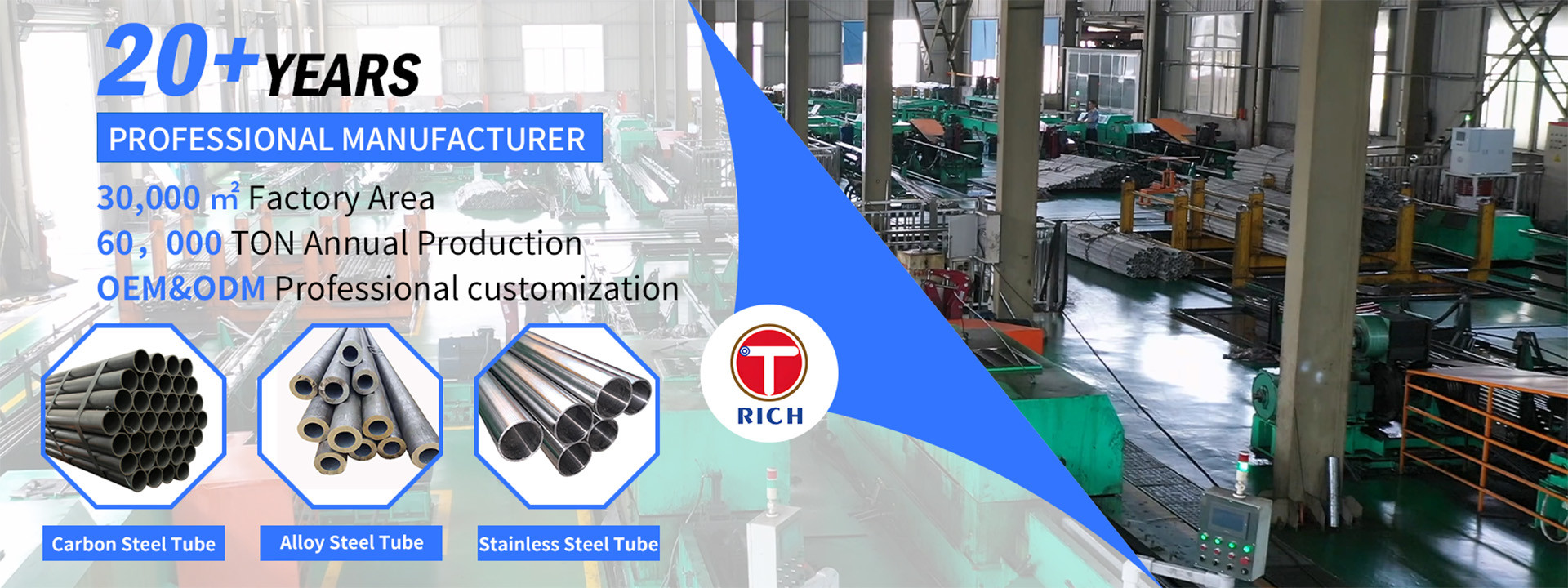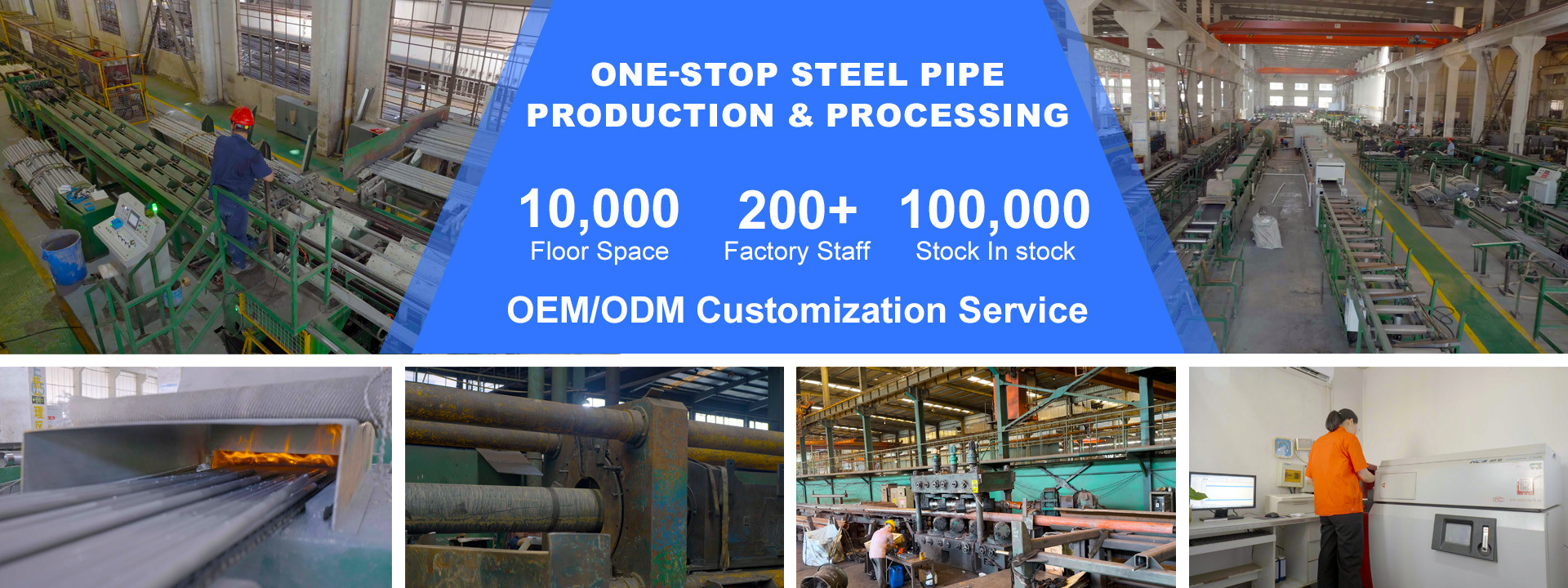What is the difference between hot finished and cold finished tube?
2025-07-18
What is the difference between hot finished and cold finished tube?
The terms "hot finished" and "cold finished" refer to the processes by which steel tubes or pipes are shaped and finished. The difference between the two primarily lies in the temperature at which the tubes are processed, which affects their mechanical properties and surface finish.
Hot Finished Tubes:
Manufacturing Process: Hot finished tubes are produced by heating steel to a high temperature (typically above 1000°C) and then shaping it through processes like extrusion, piercing, or rotary forging. The tube is then cooled to room temperature.
Surface Finish: The surface finish of hot finished tubes is typically rougher compared to cold finished tubes because of the high-temperature manufacturing process. This may require additional surface treatments for specific applications.
Mechanical Properties: Hot finishing generally results in a tube with good internal structure but with a slightly lower precision in terms of dimensions. The material tends to be more ductile, but it might also exhibit residual stresses.
Applications: Hot finished tubes are often used for applications where high precision isn't the primary concern but strength and durability are. These tubes are commonly used in structural, automotive, and heavy-duty applications.
Cost: Typically, hot finished tubes are less expensive due to the simpler manufacturing process.
Cold Finished Tubes:
Manufacturing Process: Cold finished tubes are processed at or near room temperature, following processes like cold drawing or pilgering. In these processes, the steel tube is pulled through a die to reduce its diameter and increase its length.
Surface Finish: Cold finished tubes have a much smoother surface finish compared to hot finished ones, as they undergo additional work-hardening during the drawing process. This results in a more polished, clean, and uniform surface.
Mechanical Properties: Cold finishing imparts higher strength and improved dimensional precision to the tube. Cold finished tubes also tend to have better surface hardness and are more dimensionally accurate.
Applications: Cold finished tubes are ideal for applications that require high dimensional tolerance, smooth surface finish, and superior mechanical properties. These are commonly used in hydraulic, aerospace, and precision machinery.
Cost: Cold finished tubes are generally more expensive due to the additional processing steps required to achieve higher precision and surface finish.
Summary of Key Differences:
Feature
Hot Finished Tubes
Cold Finished Tubes
Manufacturing Temp
Processed at high temperatures (above 1000°C)
Processed at room temperature or slightly higher
Surface Finish
Rougher, often requiring further treatment
Smoother, polished surface
Mechanical Properties
More ductile, lower precision
Higher strength, greater dimensional accuracy
Applications
Structural, automotive, heavy-duty uses
Hydraulic, aerospace, precision machinery
Cost
Lower cost due to simpler process
Higher cost due to additional processing
In short, hot finished tubes are suitable for less demanding applications where strength is more important than surface finish or dimensional accuracy, while cold finished tubes are designed for precision applications requiring better mechanical properties and a refined surface.
View More
What is the best pipe for a heat exchanger?
2025-07-11
What is the Best Pipe for a Heat Exchanger?
Selecting the optimal pipe for a heat exchanger is crucial for efficiency, durability, and overall system performance. Heat exchangers rely on transferring heat between fluids, and the choice of piping material and type directly affects heat transfer rates, corrosion resistance, maintenance needs, and cost.
In this article, we explore three key questions to determine the best pipe choice for a heat exchanger:
1. What Material Provides the Best Thermal Conductivity?
Thermal conductivity is a key property influencing how efficiently heat is transferred through the pipe walls.
Copper: Copper pipes are widely known for excellent thermal conductivity (about 386 W/m·K), making them highly efficient for heat transfer applications.
Stainless Steel: Stainless steel pipes have lower thermal conductivity (approximately 16 W/m·K) but offer superior corrosion resistance.
Carbon Steel: Thermal conductivity of carbon steel (~54 W/m·K) is moderate, but it can corrode easily.
Titanium: Though expensive, titanium offers good thermal conductivity (~21.9 W/m·K) with excellent corrosion resistance, especially in aggressive fluids.
Conclusion: For maximum heat transfer efficiency, copper pipes are the best. However, the decision cannot be based on thermal conductivity alone.
2. How Important is Corrosion Resistance?
Because heat exchangers often handle aggressive or corrosive fluids, corrosion resistance is vital for longevity.
Copper: Susceptible to corrosion in some chemically aggressive environments, especially in contact with ammonia or acidic fluids.
Stainless Steel: Offers excellent corrosion resistance, especially grades like 316L, making it a preferred choice in chemical and food industries.
Titanium: Outstanding corrosion resistance even in highly aggressive environments like seawater.
Carbon Steel: Prone to rust and corrosion unless properly coated or treated.
Conclusion: For corrosive fluids or harsh environments, stainless steel or titanium pipes are better choices despite higher cost and lower thermal conductivity.
3. How Do Cost and Maintenance Affect Pipe Selection?
Budget constraints and maintenance capabilities often influence the piping decision.
Copper: Moderate upfront cost, easy to install, but may require more frequent replacement in corrosive environments.
Stainless Steel: Higher initial cost but less frequent maintenance and longer service life usually reduce total cost of ownership.
Carbon Steel: Least expensive initially, but higher maintenance costs due to corrosion may arise.
Titanium: Highest upfront cost but lowest maintenance due to durability.
Conclusion: If short-term budget is a priority and the environment is not corrosive, copper or carbon steel may be considered. For long-term reliability and lower maintenance, stainless steel or titanium is preferred.
Final Conclusion
View More
What is the difference between hot rolled and cold drawn pipe?
2025-07-04
What is the Difference Between Hot Rolled and Cold Drawn Pipe?
When it comes to metal pipes, understanding the manufacturing process is key to selecting the right type for your project. Two commonly used methods for producing steel pipes are hot rolling and cold drawing. Each process yields pipes with different mechanical properties, surface finishes, dimensional tolerances, and cost implications. In this article, we will explore the differences between hot rolled and cold drawn pipes by addressing three important questions.
1. What Are Hot Rolled and Cold Drawn Pipes?
Hot Rolled Pipes:
These pipes are manufactured by heating a steel billet above its recrystallization temperature (usually above 1700°F or 926°C), then rolling it into shape. The high temperature allows the metal to be easily formed, resulting in a rough surface finish and looser dimensional tolerances. Hot rolling is typically used for producing larger diameter pipes at lower costs.
Cold Drawn Pipes:
Cold drawn pipes begin as hot rolled pipes but undergo an additional process at room temperature where the pipe is drawn through a die or over a mandrel to reduce its diameter and improve its finish. This cold working strengthens the material by strain hardening and results in tighter dimensional accuracy and a smoother surface.
2. How Do Mechanical Properties Differ Between Hot Rolled and Cold Drawn Pipes?
Strength and Hardness: Cold drawn pipes generally have higher tensile strength and hardness due to strain hardening during the cold drawing process. Hot rolled pipes, while still robust, are comparatively softer and less strong.
Ductility: Hot rolled pipes tend to have better ductility because the high temperature rolling process refines the grain structure without extensive strain hardening. Cold drawn pipes are less ductile but stronger.
Residual Stresses: Cold drawing introduces residual stresses into the pipe material, often requiring stress relief annealing if precision or stability is critical. Hot rolled pipes typically have fewer residual stresses.
3. What Are the Differences in Surface Finish, Dimensions, and Cost?
Surface Finish: Hot rolled pipes have a rougher, scaly surface due to oxidation at high temperatures, often requiring additional machining or treatment. Cold drawn pipes have a much smoother, polished finish suitable for applications where appearance and tight fit are important.
Dimensional Accuracy: Cold drawn pipes offer much tighter dimensional tolerances and more consistent wall thicknesses compared to hot rolled pipes, making them preferable in precision applications.
Cost: Hot rolled pipes are generally less expensive to produce due to the simpler process and lower energy input. Cold drawn pipes involve additional processing and thus cost more.
Conclusion
The choice between hot rolled and cold drawn pipes depends largely on your application's requirements:
Use hot rolled pipes when cost efficiency, ductility, and larger diameters are prioritized and a rougher surface finish is acceptable.
Opt for cold drawn pipes when higher strength, superior surface finish, precise dimensions, and tighter tolerances are critical.
Understanding these differences will help you make an informed decision for your construction, manufacturing, or engineering projects.
View More
What is a cold drawn seamless tube?
2025-06-27
What is a Cold Drawn Seamless Tube?
Cold drawn seamless tubes are integral components in various industries, from automotive to oil and gas, where precision and quality are paramount. Understanding what they are, how they are manufactured, and their benefits can help in selecting the right tube for specific applications.
What is a Cold Drawn Seamless Tube?
A cold drawn seamless tube is a type of metal tube produced by drawing a hollow seamless tube through a die at room temperature. Unlike welded or hot finished tubes, these tubes maintain their seamless integrity without any joints or welds. The cold drawing process improves the tube’s mechanical properties, dimensional accuracy, and surface finish, making it suitable for high-precision applications.
Key Questions about Cold Drawn Seamless Tubes
1. How is a cold drawn seamless tube manufactured?
The manufacturing process begins with a hot finished or extruded seamless tube. This tube is then subjected to cold drawing, where it is pulled through a die and over a mandrel to reduce its diameter and wall thickness, all while at room temperature. This process work-hardens the material, improving its strength and surface finish. The tube is then annealed if necessary, to relieve stresses and enhance ductility.
2. What are the advantages of cold drawn seamless tubes over other types?
Cold drawn seamless tubes have several advantages:
Superior dimensional accuracy: Tighter tolerances can be achieved compared to hot finished tubes.
Better surface finish: The cold drawing process produces a smoother exterior and interior surface.
Enhanced mechanical properties: Cold work hardening increases yield strength and tensile strength.
Improved metallurgical structure: No weld seam means the integrity of the tube is uniform throughout.
Suitable for precision components: Ideal for hydraulic cylinders, automotive parts, and aerospace applications.
3. What are the common applications of cold drawn seamless tubes?
Due to their strength, precision, and smooth surfaces, cold drawn seamless tubes find extensive use in:
Automotive industry: For shafts, axles, and suspension components.
Hydraulic and pneumatic systems: For cylinders and piston rods.
Oil and gas: In high-pressure lines and structural components.
Construction and machinery: Where high strength and dimensional precision are required.
Aerospace: For critical components requiring tight tolerances and corrosion resistance.
View More
Is a stainless steel heat exchanger better than aluminum?
2025-06-20
Is a Stainless Steel Heat Exchanger Better Than Aluminum?
When selecting a material for a heat exchanger, two popular choices often come up: stainless steel and aluminum. Each has its own advantages and drawbacks depending on the application, environment, and performance requirements. This article explores the key differences between stainless steel and aluminum heat exchangers by answering three critical questions.
1. Which Material Has Better Thermal Conductivity?
Thermal conductivity is crucial for the efficiency of a heat exchanger since it affects how quickly heat transfers from one medium to another.
Aluminum: Has very high thermal conductivity, approximately 205 W/m·K.
Stainless Steel: Has significantly lower thermal conductivity, around 15-25 W/m·K depending on the alloy.
Conclusion: Aluminum excels in heat transfer efficiency due to its superior thermal conductivity. Heat exchangers made from aluminum generally offer faster heat exchange.
2. How Do Stainless Steel and Aluminum Compare in Terms of Durability and Corrosion Resistance?
Heat exchangers often work in harsh environments, making durability and corrosion resistance vital.
Stainless Steel: Known for exceptional corrosion resistance, especially to rust and chemical damage. It performs well in aggressive environments, including acidic or saline conditions.
Aluminum: While lightweight and corrosion-resistant due to its oxide layer, aluminum can corrode faster in certain acidic or alkaline conditions and is generally less resistant to mechanical damage.
Conclusion: Stainless steel is superior when it comes to durability and reliable corrosion resistance, particularly in demanding environments.
3. What About Cost and Weight Considerations?
Practical factors like cost and weight influence the choice depending on budget and application constraints.
Cost: Aluminum is usually less expensive both in raw material and fabrication costs. Stainless steel tends to be more costly.
Weight: Aluminum is much lighter (approximately one-third the density of stainless steel), making it preferable where weight reduction is important, such as in automotive or aerospace applications.
Conclusion: Aluminum offers better cost-effectiveness and significant weight savings, which can be critical depending on the use case.
Final Verdict
Is a stainless steel heat exchanger better than aluminum? The answer depends on your specific priorities:
If thermal efficiency and low weight are top concerns, aluminum heat exchangers are generally better.
If durability, long-term corrosion resistance, and operation in harsh environments are crucial, stainless steel is the superior choice.
Budget constraints and fabrication needs also play an important role in determining the most suitable material.
View More






